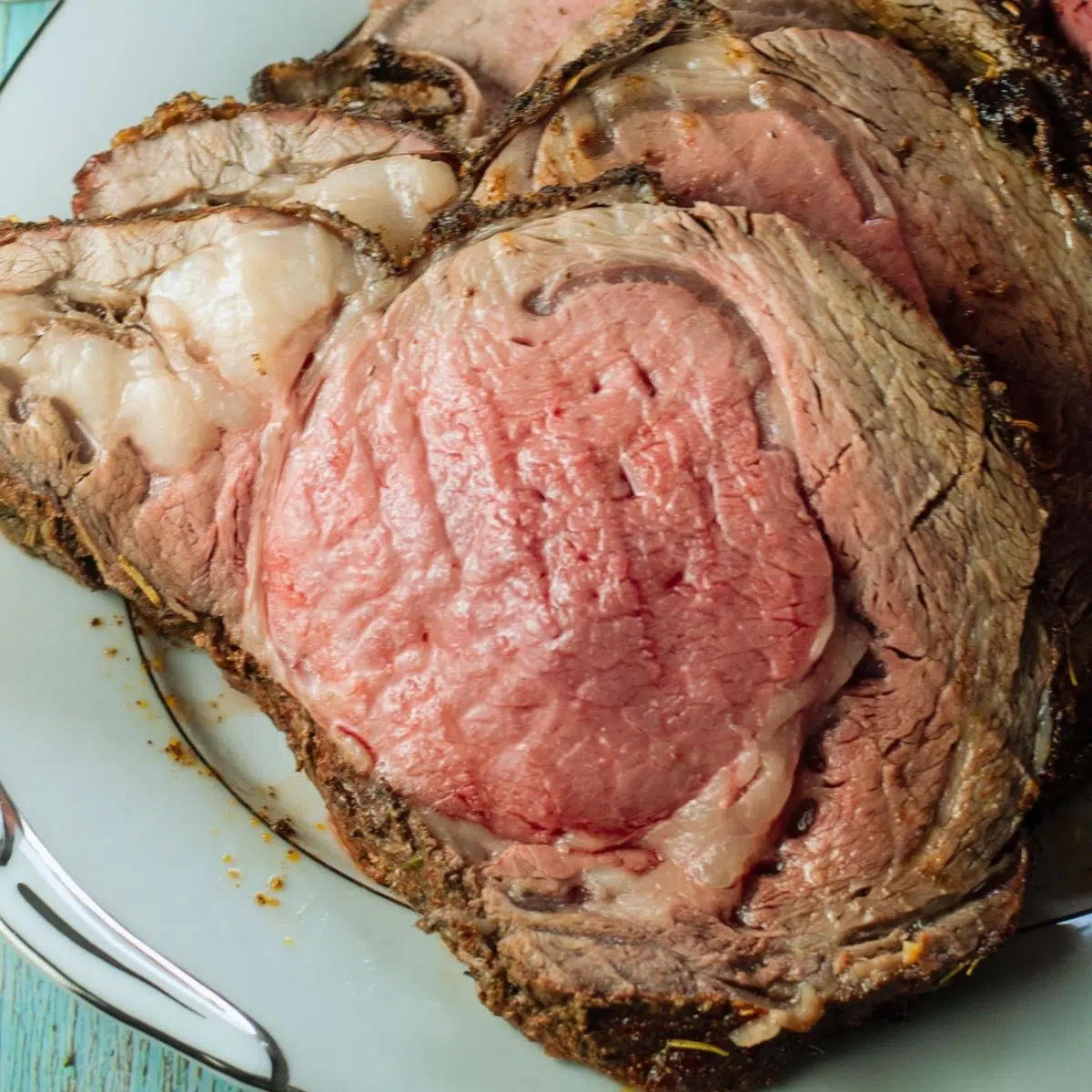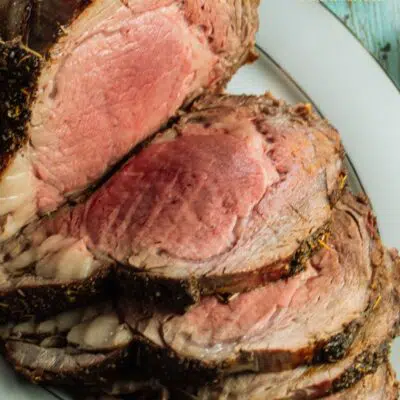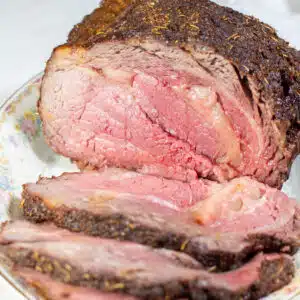Ensure you know the proper prime rib cooking temperatures before making this delicious beef cut. The cooking temperature and internal temperature are important in making sure your prime rib is not over or undercooked, but just right.

Jump to:
- Temperature Is Key To Perfecting Your Roasts
- The Ideal Doneness for Prime Rib
- Is it Safe to Eat Medium Rare Prime Rib?
- Do I Have to Serve Prime Rib Medium Rare?
- Table 1: Desired Doneness for Prime Rib
- What Temperature Do You Cook Prime Rib?
- How Long Do You Cook Prime Rib?
- How to Test If Your Prime Rib is Done
- Tips for Cooking
- How to Prepare Prime Rib
- 📖 Recipe Card
- 💬 Comments & Reviews
Temperature Is Key To Perfecting Your Roasts
Prime rib is one of those cuts of meat that you may think is difficult to cook. This is a common misconception because it is a higher-priced cut of meat and is mostly served on special occasions.
You don’t have to go to a restaurant for Sunday brunch to enjoy this delectable meat though. With a few simple tips, you can easily make an amazing prime rib at home for your next Easter brunch or another special occasion.
The Ideal Doneness for Prime Rib
When cooking prime rib at home, it is important to know the right temperature to cook it at, how long to cook it for, and what the desired level of doneness is.
Typically, prime rib is considered best when served medium-rare. When checking the roast's internal temperature, you want it to be between 130-135°F (35-37°C).
Prime rib is one of those cuts of meat that you may think is difficult to cook. This is a common misconception because it is a higher-priced cut of meat and is mainly served on special occasions.
You don’t have to go to a restaurant for Sunday brunch to enjoy this delectable meat. With a few simple tips, you can easily make an impressive prime rib at home for your next Easter brunch or another special occasion.
Is it Safe to Eat Medium Rare Prime Rib?
Technically, 130-135°F (35-37°C) is below the suggested internal temperature to consume meat. The USDA recommends serving prime rib and other roasts at 145°F (63°C) or above to help prevent foodborne illnesses.
This is an important consideration, however, many chefs still safely serve prime rib at medium-rare.
When cooking any cut of meat you intend to serve below medium, purchasing it from a reputable butcher is recommended.
While it may be a bit more expensive than grabbing on in the grocery aisle, buying from a local butcher will give you the highest quality of meat (and you get to support local businesses in your area).
Do I Have to Serve Prime Rib Medium Rare?
While it is traditionally cooked to medium-rare, this is not a hard and fast rule. Many prefer their prime rib to be a bit more cooked throughout.
You are the one eating the prime rib; therefore, choose the doneness you and your guests prefer. If you have a lot of varying tastes, cooking the prime rib to medium or medium-well will give options of doneness to serve: well done on the outer edges and medium in the center.
Use the recommendations below to determine what temperature your desired doneness is when cooking prime rib at home.
Table 1: Desired Doneness for Prime Rib
| Doneness | Internal Temperature | Appearance |
|---|---|---|
| Rare | 120-125°F/49-52°C | Bright red center, lukewarm. |
| Medium Rare | 130-135°F/54-57°C | Bright red center, pink edges, warm. |
| Medium | 135-145°F/57-63°C | Pink and warm throughout. |
| Medium Well Done | 145-155°F/63-68°C | Slightly pink center and warm throughout. |
| Well Done | 155-165°F/68-74°C | Very little to no pink. |
What Temperature Do You Cook Prime Rib?
Whether you decide on medium-rare or something a bit more well done, you can cook your prime rib in the same fashion and at the same temperature.
The ideal way to cook prime rib is by following a low-and-slow method. Some cooks prefer to cook prime ribs at a very low temperature of 250°F (120 °C) for several hours.
Many others like to cook at a slightly higher temperature so that it does not take quite as long to cook.
Cooking your prime rib at either 250°F (120°C), which is ideal for smoking a prime rib roast, or 325°F (160°C) will result in delicious prime rib. Choose what works best for your time and the size of the roast you are cooking.
>>>See All Of My Tasty Recipes Here!<<<
How Long Do You Cook Prime Rib?
Temperature and time go hand in hand when cooking the perfect prime rib. Another important factor is the size of your roast.
In addition to these factors, you need to decide if you would like to brown your roast before lowering the temperature (this is great for sealing in the juices and getting a nicely crusted outside).
Before following the guidelines below, preheat your oven to 450°F (230°C). Place your seasoned prime rib in a shallow roasting pan with the fat side down.
Set the pan in the oven and sear the roast for 15 minutes. Then lower the temperature to either 250°F (120°C) or 325°F (160°C) and follow the guidelines below.
First, identify how large the roast is to determine how long you need to cook your prime rib. Then, use the chart below to help you determine how long to cook your prime rib at either temperature.
How Long to Cook Prime Rib at 250°F (120°C)
Cook your prime at 250°F degrees for 25 minutes per pound of meat
| 2-pound prime rib | 50 minutes |
| 3-pound prime rib | 1 hour and 15 minutes |
| 4-pound prime rib | 1 hour and 40 minutes |
| 5-pound prime rib | 2 hours and 5 minutes |
| 6-pound prime rib | 2 hours and 30 minutes |
| 7-pound prime rib | 2 hours and 55 minutes |
| 8-pound prime rib | 3 hours and 20 minutes |
| 9-pound prime rib | 3 hours and 45 minutes |
| 10-pound prime rib | 4 hours and 10 minutes |
How Long to Cook Prime Rib at 325°F (160°C)
Cook your prime rib for approximately 17-20 minutes per pound of meat. (This chart rounds the cooking time to around 17 minutes per/pound to help avoid overcooking).
| 2-pound prime rib | 35 minutes |
| 3-pound prime rib | 50 Minutes |
| 4-pound prime rib | 1 hour and 10 minutes |
| 5-pound prime rib | 1 hour and 25 minutes |
| 6-pound prime rib | 1 hour and 40 minutes |
| 7-pound prime rib | 2 hours |
| 8-pound prime rib | 2 hours 15 minutes |
| 9-pound prime rib | 2 hours 30 minutes |
| 10-pound prime rib | 2 hours 45 minutes |
Keep in mind that cooking times are approximations. Depending on your oven and the starting temperature of the prime rib (as well as many other considerations), your cooking time may vary.
The times listed above are good starting points, so follow the guide. Then, use your meat thermometer to test the internal temperature and adjust times as needed.
How to Test If Your Prime Rib is Done
Before you begin cooking your prime rib, ensure you have a meat thermometer on hand. If you don’t have one, you want to buy one before cooking your prime rib.
With a large cut of meat like a prime rib and one that you are working hard to get the exact level of doneness, a meat thermometer is the best tool to use.
To test the meat, pull it out of the oven. Leave it on the oven rack if you like; just be mindful of the hot rack.
Insert the meat thermometer into the thickest part of the roast and wait for the temperature to register.
Important Note on Testing Internal Temperature:
You want to pull your prime rib out of the oven before it reaches your desired temperature! For example, if you want a perfect medium rare prime rib at 130-135°F (35-37°C), you will want to stop cooking it when it reaches 120-125°F (49-52°C) on the thermometer.
After removing the prime rib from your oven, it will continue to cook for up to 30 minutes while resting. This is called carryover cooking.
Therefore, to ensure it doesn’t accidentally overcook once it’s out of the oven – take your roast out early.
Tips for Cooking
- Remove your prime rib from the refrigerator at least an hour before cooking, and let it sit on the counter. Letting it sit out for 2 hours is best, and if you're comfortable with longer times, then you can set your roast out for up to 8 hours.
- Allowing the meat to come to room temperature before cooking will ensure that your prime rib will cook more evenly throughout.
- Remove the prime rib from the oven when the internal temperature is 5-10 degrees less than your desired doneness.
- Remove the prime rib when finished cooking and let it sit (uncovered or loosely tented with aluminum foil) to rest for 20-30 minutes before serving. This allows the meat to continue to cook internally and will give you the best taste and texture.
How to Prepare Prime Rib
The great thing about prime rib is that because it is such a high-quality cut of meat, you do not need to do much to get the most from it. Many cooks find that a simple seasoning of salt and pepper is perfect.
Just because it can be made with a simple seasoning doesn’t mean you can’t enjoy adding more flavor! Fresh garlic or herbs like rosemary can be excellent flavor additions to prime rib.
If you want a delightful and savory prime rib, try out my recipe for an oven-roasted prime rib with prime rib rub.
If you are curious about how to smoke prime rib, you can also try my recipe for smoked prime rib!
Do you love a recipe you tried? Please leave a 5-star 🌟rating in the recipe card below and/or a review in the comments section further down the page.
Stay in touch with me through social media @ Pinterest, Facebook, Instagram, or Twitter! Subscribe to the newsletter today (no spam, I promise)! Don't forget to tag me when you try one of my recipes!
📖 Recipe Card
Prime Rib Cooking Temperatures: A Complete Guide To Roasting Prime Rib
Ingredients
Boneless Prime Rib Roast
- 5 lb prime rib (boneless roast or standing rib roast)
- 2 tablespoon horseradish (for coating the roast)
Prime Rib Rub
- 1 ½ tablespoon kosher salt
- 1 tablespoon coarse ground pepper (freshly ground is best)
- ½ tablespoon garlic powder
- 1 teaspoon smoked paprika (or regular paprika)
- 1 teaspoon dried rosemary
- 1 teaspoon ground sage
- 1 teaspoon dried thyme
- ½ teaspoon dried oregano
- ½ teaspoon onion powder
(Note: 2x or 3x only changes the ingredient list)
Instructions
Preparation
- First, rinse your prime rib roast under cool running water, then pat it dry using paper towels. Slice off any excess fat or silver skin if desired. If possible, set your roast out 1-2 hours before cooking to come to room temperature.
- (optional) Use butcher twine to tie your roast. For boneless prime rib, space the twine out every 1.5 inches down the length of the roast.
Prime Rib Rub
- In a small bowl, combine all of the dry rub ingredients (salt, pepper, smoked paprika, garlic powder, onion powder, ground sage, dried rosemary and dried thyme) and set it aside.
- Put your roast on a baking sheet or in a baking dish coat it with the 2 tablespoons of horseradish all over. Season it generously with the dry rub on all sides. Massage the seasoning into the meat and roll the edges of the roast in any excess that has fallen off.
Roasting The Prime Rib
- Preheat your oven to 200°F (93°C).
- Transfer the prepared roast to a roasting pan (fat-side-up for boneless roasts or bone-side-down for a standing rib roast). Place in the oven and roast for about 3 hours and 45 minutes, or roughly 45 minutes per pound.
- Once your roast has an internal temperature of 120-125°F (49-52°C) for RARE, 125-129°F (52-54°C) for MEDIUM RARE, 130-139°F (54-59°C) for MEDIUM, or 140-145°F (60-63°C) for MEDIUM DONE, take it out of the oven and loosely tent a piece of foil over the top. Let it rest for 20-30 minutes before slicing and serving.
(Optional) Reverse Sear
- If you would like to reverse sear your roast, take it out of the oven 10°F (5.5°C) shy of your ideal internal temperature. Transfer it to a cutting board and cover it with aluminum foil as you bring up the temperature of the oven to 500°F (260°C).
- Once the oven comes to temperature, return the roast for 5-10 minutes or until it reaches your desired internal temperature. *This will happen quickly so keep a close eye on it.
- Remove the seared prime rib from the oven and tent a piece of foil loosely over the top. Let it rest for 15 minutes before slicing and serving.
Notes
- If you don't have or don't like horseradish, you can try making this Christmas prime rib roast using a horseradish substitute.
- Always check the internal temperature of your meat in the thickest part. It is good practice to check a few other areas toward the center to confirm doneness.
- Remember, the internal temperature for your roast will continue to increase 5-7°F (3-4°C) after being removed from the oven, also known as 'carryover cooking'. Plan for this by removing the roast just shy of your ideal temperature.
- To store: Allow the Christmas prime rib roast to cool, then place it in an airtight container and refrigerate it for up to 5 days.
- To freeze: Wrap the roast in plastic wrap and place it in a heavy-duty freezer bag or airtight container. Freeze for up to 6 months and thaw in the fridge overnight before reheating. Check out my post 'how long can you keep prime rib in the freezer' for more information.
- To reheat: Place the roast in a baking dish with up to ¼ cup of beef broth (depending on how much meat there is) and bake at 300°F (150°C) until it reaches your desired internal temperature.



Maureen Dolhancey says
Thank you for the recipe
Excellent information
Texasbush says
Bought a prime rib roast today, will give your method a try, and will always keep my thermometer close by. Thanks again for your advice and tips ,will try to let you know how everything went.